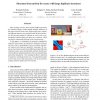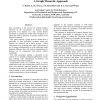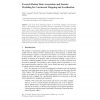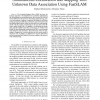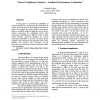289
Voted
CVPR
2011
IEEE
14 years 8 months ago
2011
IEEE
This paper addresses the problem of simultaneous tracking of multiple targets in a video. We first apply object detectors to every video frame. Pairs of detection responses from ...
125
Voted
CVPR
2011
IEEE
14 years 8 months ago
2011
IEEE
Most existing structure from motion (SFM) approaches for unordered images cannot handle multiple instances of the same structure in the scene. When image pairs containing differen...
97
Voted
ICPR
2010
IEEE
14 years 10 months ago
2010
IEEE
Tracking by association of low frame rate detection responses is not trivial, as motion is less continuous and hence ambiguous. The problem becomes more challenging when occlusion ...
113
Voted
CVIU
2006
15 years 25 days ago
2006
Vision-based tracking is a basic elementary task in many computer vision-based applications such as video surveillance and monitoring, sensing and navigation in robotics, video co...
107
Voted
RSS
2007
2007
Simultaneous Localisation and Mapping in Dynamic Environments (SLAMIDE) with Reversible Data Associa
15 years 2 months ago
Abstract— The conventional technique for dealing with dynamic objects in SLAM is to detect them and then either treat them as outliers [20][1] or track them separately using trad...
108
click to vote
ICRA
2000
IEEE
15 years 5 months ago
2000
IEEE
Data association is the process of relating features observed in the environment to features viewed previously or to features in a map. Correct feature association is essential fo...
109
Voted
ISRR
2001
Springer
15 years 5 months ago
2001
Springer
One of the most challenging aspects of concurrent mapping and localization (CML) is the problem of data association. Because of uncertainty in the origins of sensor measurements, i...
102
click to vote
IPSN
2003
Springer
15 years 6 months ago
2003
Springer
Abstract. The issue of data association arises frequently in sensor networks; whenever multiple sensors and sources are present, it may be necessary to determine which observations...
111
click to vote
ICRA
2003
IEEE
15 years 6 months ago
2003
IEEE
— The Extended Kalman Filter (EKF) has been the de facto approach to the Simultaneous Localization and Mapping (SLAM) problem for nearly fifteen years. However, the EKF has two ...
125
Voted
JVA
2006
IEEE
15 years 6 months ago
2006
IEEE
In this paper we consider the capabilities of nearest neighbor as a criterion of data association to ensure correct decision in associating measurement to target. We continue the ...
